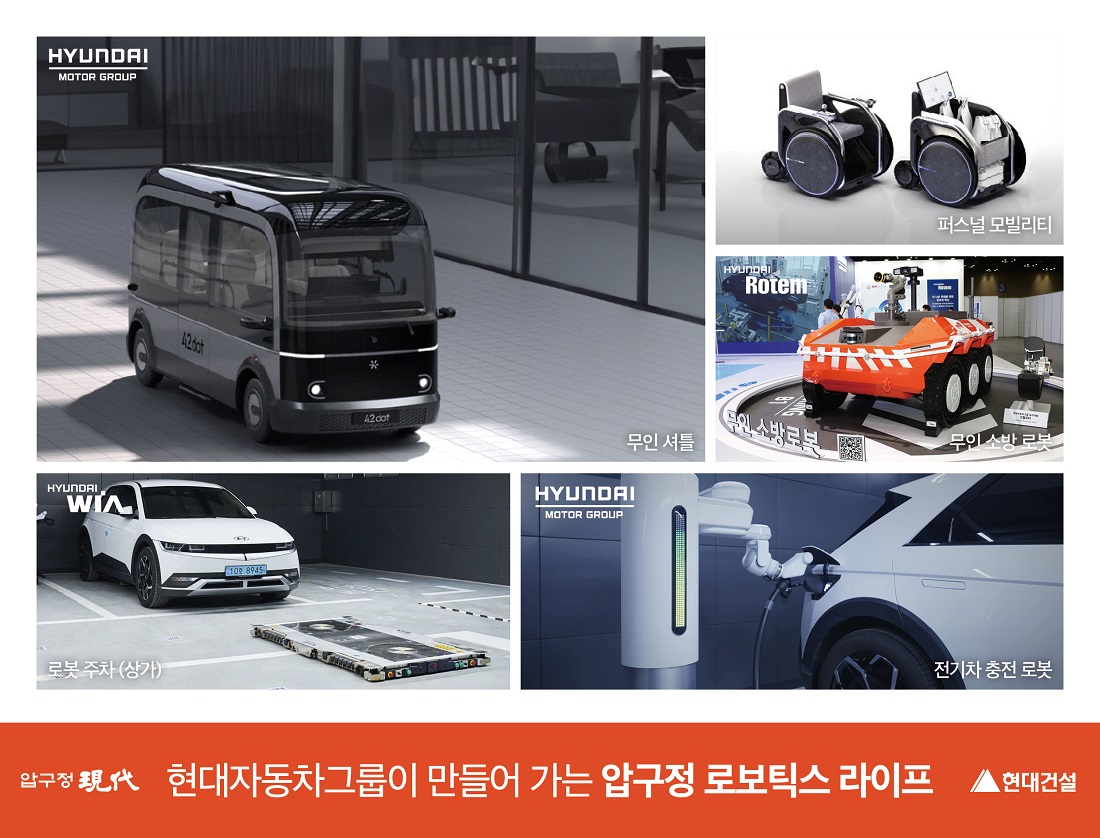Press Release
Hyundai E&C Leads Future Housing Innovation with Robot-Friendly Apartment Complex
▲ Proposes a robot-based smart city model that supports all aspects of residents' lives, including mobility, safety, and convenience
▲ Hyundai E&C’s autonomous delivery robot, first commercialized at THE H Daechi Edellui, set to undergo additional technological and service improvements
▲ Accelerates housing innovation model where humans and robots coexist by integrating the robot technology expertise of the Hyundai Motor Group

Hyundai E&C has presented a blueprint for future cities where humans and robots coexist by building the construction industry's first robot-friendly apartment complex.
Hyundai E&C announced plans to develop Korea's first robot-friendly apartment complex in Apgujeong District 2, which will be the starting point of a new housing model for the coming century, and to subsequently extend it into a robot-based smart city model.
As part of such efforts, navigation routes and systems were optimized by taking into account robot operation from the design stage of the complex. The design ensures that elevators, automatic doors, and communication networks are all linked with the robots, allowing them to move freely throughout the entire complex. In addition to securing space for smooth movement, an IoT-based control system is incorporated, enabling robots to independently move between floors and open and close doors. Thanks to this, fully autonomous robot movement is expected to be possible beginning from the road outside the complex, through the underground parking garage and common entrances, and via the elevators, all the way to the front door of individual apartment units.
Hyundai E&C has presented a new housing paradigm that supports all aspects of daily life—including mobility, convenience, safety, and EV charging and parking—by integrating the capabilities of its group affiliates, including the ▲Hyundai Motor Group Robotics Lab, ▲Hyundai Rotem, and ▲Hyundai WIA. The paradigm has been designed so that robots linked to a physical AI platform move autonomously throughout the complex, becoming partners in residents’ everyday lives.
Inside the complex, an unmanned ‘roboshuttle’ service in the form of Hyundai-Kia's ‘Shucle’ will be operated. ‘Shucle’ is the Hyundai Motor Group's Mobility on Demand service platform, which can flexibly adjust its routes and operating times according to real-time passenger demand. This not only increases the efficiency of movement within the complex but also has the significance of providing a safe means of transport for those with mobility challenges.
A personal mobility robot offering customized transport services will also be introduced. Based on a small autonomous mobile platform, it can not only carry heavy loads from a shopping trip to one's doorstep but also deliver packages safely to their destination without delivery mishaps, through functions like facial recognition. In the future, by combining this technology with a diverse range of solutions, residents with mobility difficulties can be guided and assisted when they visit community facilities within the complex.
Additionally, to promote residents’ safety, the complex will feature an unmanned firefighting robot built by Hyundai Rotem. This robot can be deployed even in high-temperature and toxic gas environments and, through a thermal imaging camera and special equipment, can respond quickly in fires where firefighting personnel have limited access, thereby protecting the lives of residents and minimizing property damage.
An electric vehicle (EV) charging robot, designed to make a convenient living environment even more convenient, is also drawing attention. When a vehicle enters the charging area, the robot autonomously opens the charging port, connects the cable, and begins charging. When charging is complete, it automatically disconnects the cable and notifies the car owner. It also detects, in real-time, any overheating or other incidents that may occur during the charging process. Using this system, residents will be able to seamlessly charge their vehicles without any additional effort, regardless of the external environment.
The parking lot of the commercial building within the complex will be equipped with a valet parking robot designed by Hyundai WIA. When a vehicle is parked in a designated spot, the robot lifts the vehicle by its wheels and parks it in an empty space nearby. Since the robot can move with precision even in tight spaces, more vehicles can be accommodated within the same area, thereby boosting parking convenience for visitors to the commercial building.
A Hyundai E&C official noted, “Apgujeong District 2 will be the first residential development that features a differentiated robot solution that covers mobility, convenience, safety, and EV charging and parking.” The official added, “Hyundai E&C will foster a future-oriented residential culture where humans and robots coexist, integrating diverse technologies and services.”
Hyundai E&C, the first in the industry to successfully commercialize an autonomous robot delivery service, is now expanding its robot-related services. The company also rolled out its integrated indoor-outdoor D2D (Door-to-Door) autonomous robot delivery service at THE H Daechi Edellui this past August. This autonomous robot delivery service, jointly developed with the robotics startup Mobinn, is a system that provides unmanned delivery of food, beverages, and parcels from the complex entrance, via the elevator, to the front door of individual apartment units, and has received major acclaim from residents.


